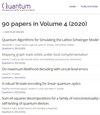Universal adjointation of isometry operations using conversion of quantum supermaps
IF 5.1
2区 物理与天体物理
Q1 PHYSICS, MULTIDISCIPLINARY
引用次数: 0
Abstract
Identification of possible transformations of quantum objects including quantum states and quantum operations is indispensable in developing quantum algorithms. Universal transformations, defined as input-independent transformations, appear in various quantum applications. Such is the case for universal transformations of unitary operations. However, extending these transformations to non-unitary operations is nontrivial and largely unresolved. Addressing this, we introduce $\textit{isometry adjointation}$ protocols that transform an input isometry operation into its adjoint operation, which include both unitary operation and quantum state transformations. The paper details the construction of parallel and sequential isometry adjointation protocols, derived from unitary inversion protocols using quantum combs and the (dual) Clebsch-Gordan transforms, and achieving optimal approximation error. This error is shown to be independent of the output dimension of the isometry operation. In particular, we explicitly obtain an asymptotically optimal parallel protocol achieving an approximation error $\epsilon = \Theta(d^2/n)$, where $d$ is the input dimension of the isometry operation and $n$ is the number of calls of the isometry operation. The research also extends to isometry inversion and universal error detection, employing semidefinite programming to assess optimal performances. The findings suggest that the optimal performance of general protocols in isometry adjointation and universal error detection is not dependent on the output dimension, and that indefinite causal order protocols offer advantages over sequential ones in isometry inversion and universal error detection.利用量子超映射转换的等距运算的普遍自洽
识别量子对象的可能变换,包括量子态和量子操作,是开发量子算法必不可少的。通用变换被定义为与输入无关的变换,出现在各种量子应用中。这就是酉运算的全称变换的情况。然而,将这些转换扩展到非单一操作是非常重要的,并且在很大程度上没有解决。为了解决这个问题,我们引入$\textit{isometry adjointation}$协议,将输入等距操作转换为伴随操作,其中包括幺正操作和量子态转换。本文详细介绍了利用量子梳和(对偶)Clebsch-Gordan变换导出的酉反演协议的并行和顺序等距自洽协议的构造,并实现了最优逼近误差。该误差与等距操作的输出尺寸无关。特别是,我们显式地获得了一个逼近误差$\epsilon = \Theta(d^2/n)$的渐近最优并行协议,其中$d$是等距操作的输入维数,$n$是等距操作的调用次数。研究还扩展到等距反演和通用误差检测,采用半定规划来评估最佳性能。研究结果表明,通用协议在等距反演和通用误差检测方面的最佳性能不依赖于输出维数,不确定因果顺序协议在等距反演和通用误差检测方面优于顺序协议。
本文章由计算机程序翻译,如有差异,请以英文原文为准。
求助全文
约1分钟内获得全文
求助全文
来源期刊

Quantum
Physics and Astronomy-Physics and Astronomy (miscellaneous)
CiteScore
9.20
自引率
10.90%
发文量
241
审稿时长
16 weeks
期刊介绍:
Quantum is an open-access peer-reviewed journal for quantum science and related fields. Quantum is non-profit and community-run: an effort by researchers and for researchers to make science more open and publishing more transparent and efficient.
 求助内容:
求助内容: 应助结果提醒方式:
应助结果提醒方式:


